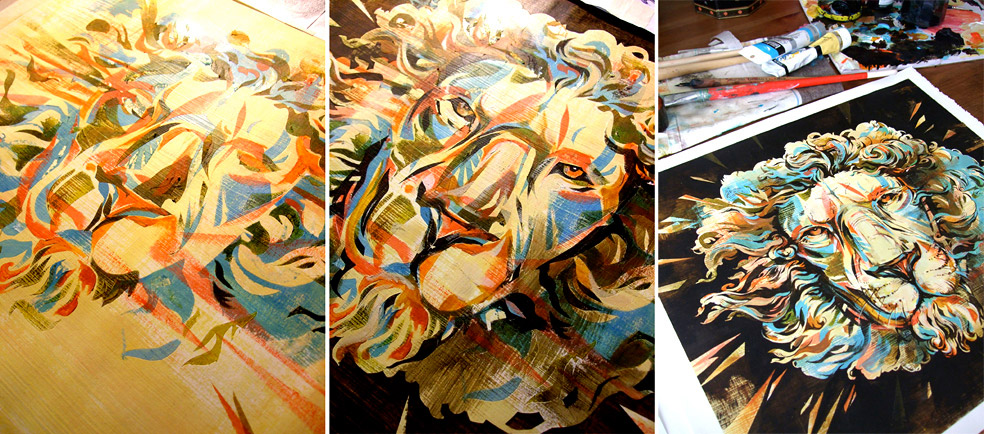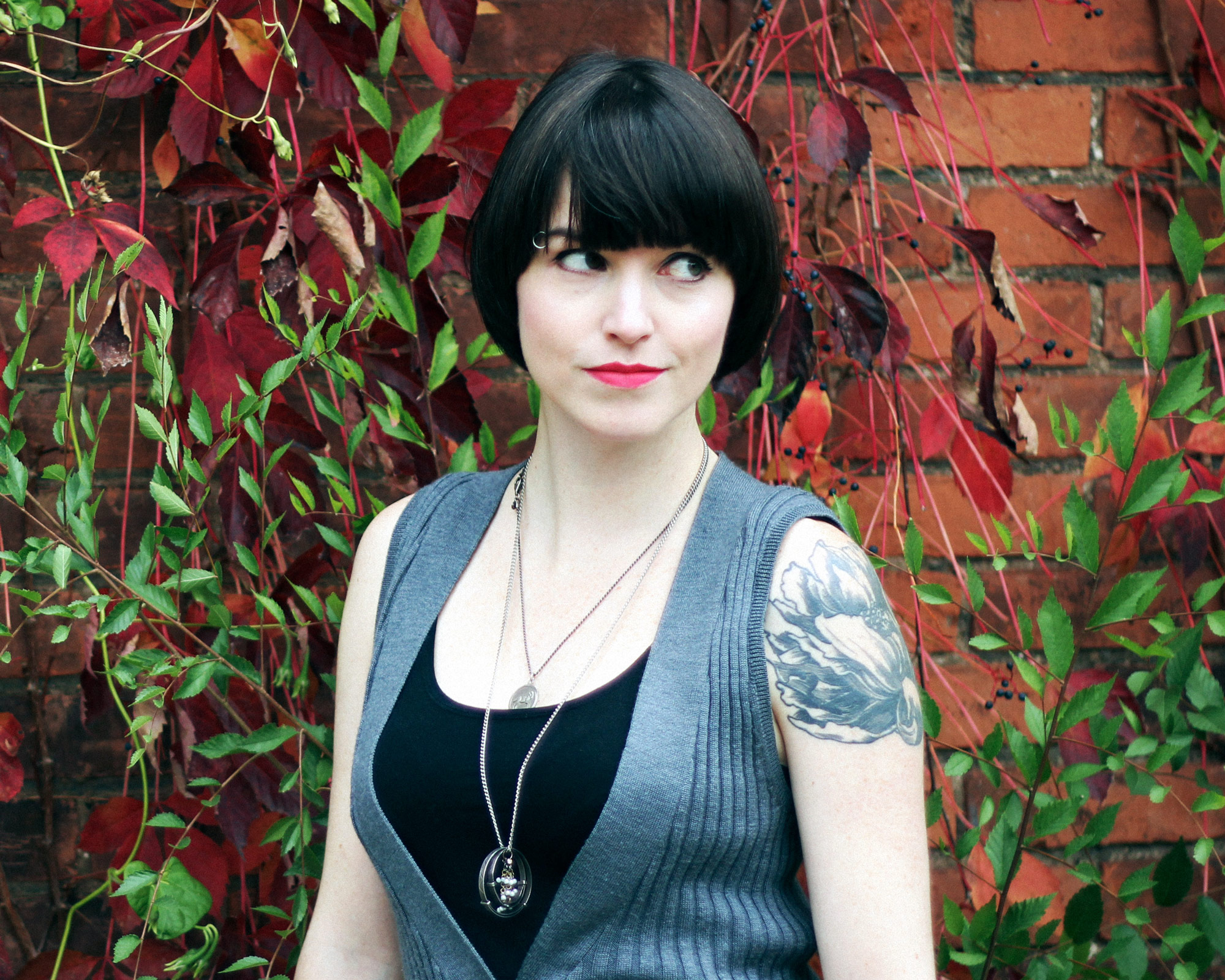
- Interview by Tina Essmaker October 23, 2012
- Photo by Jamie Lawson
Jacqui Oakley
- illustrator
- typographer
Jacqui Oakley has been illustrating for over a decade and specializes in hand-lettering and portraiture. Born in Canada, she spent her formative years in Bahrain, England, Zambia, and Libya while her parents traveled for work. She returned to Canada in 1989 and graduated from Sheridan College’s School of Art and Design in 2001. She teaches illustration at Ontario College of Art and Design and lives in Hamilton with her husband, Jamie Lawson.
Interview
Describe your path to becoming an illustrator and letterer.
I went to university for art and art history because I wanted to be an artist or do something with art, but I didn’t quite know what that would be. I was in school for a few months and really not feeling the program—it didn’t seem challenging enough and I wasn’t being given enough critical feedback, which I needed or else I would become lazy. I had a friend who was going to Sheridan College for illustration and I went there to visit. At Sheridan, I saw all the amazing work being done by students. It wasn’t just illustration—it was life drawing and painting and all the basic foundational skills that were being covered. Students there were working with all sorts of mediums and that was really exciting. I went back to my school and finished out the year and then transferred into Sheridan’s Illustration program because it just seemed like the right thing to do.
What I liked about illustration was that it allowed me to communicate to a larger audience. The work wasn’t just shown in art galleries—it was published in magazines and viewed by people everywhere. I felt like that would allow me to have more of an impact and be part of the larger conversation about what was going on.
Did you grow up in Canada?
No. My parents are English, so that’s why I sort of have an English accent, but my English family members think I sound like a Yank. (laughing) I was born in Hamilton, Ontario, and a few months later, we moved to Africa. We also lived in Libya, Zambia, and England off and on, but most of my childhood was spent in Bahrain in the Middle East. Then, when I was a teenager, my family moved back to Canada.
Did your parents move around for work?
Yes. My dad is an engineer and wanted to travel so we could all have that experience. Bahrain’s school system didn’t go longer than age 12, which meant I would have had to go off to boarding school in England. I didn’t want to do that, so I uprooted the family and we gave up the palm trees and moved back to Canada. (laughing)
Was it a big shift to move from Bahrain to Canada?
Yes. It was a funny culture clash moving here from the Middle East. It’s probably different there now, but when I lived in Bahrain, there wasn’t a movie theater; there was a really good roller-skating rink though. Moving to Canada as a teenager, I didn’t want to stick out; I was already a shy kid and I had an accent, which didn’t help me blend in in Canada.
I remember taking a French test right after we moved to Canada. The test was the names of famous Canadians written down in a column and beside each name, we had to write the person’s occupation in French. One of the people was the hockey player, Wayne Gretzky, and I had no clue who he was.
(all laughing)
I had never even seen snow before and I certainly had no idea who this guy was. I went to the teacher and quietly told her, “I’m sorry—I don’t know who Wayne Gretzky is.” She loudly exclaimed, “You don’t know who Wayne Gretzky is?!” The whole class heard and I was mortified!
That’s a really great story. How was creativity a part of your childhood in all those places you lived?
Well, it’s hard to tell what my life would be like otherwise—that was my regular day-to-day world. I remember being really excited to come visit Canada because, to me, that was the exotic place at the time.
We didn’t have a lot of TV In Bahrain and there were only two channels that were in English. Our cartoons would be cut off halfway through programming due to the prayer intermission because it was an Islamic country, so we’d just go outside and play made-up games because the weather was so good there. We also travelled to other countries a lot during the summer and my siblings and I each got to carry our own little backpacks on the airplane—we filled them with sketchbooks and games. I liked to make up my own board games, which I forced my poor younger siblings to play with me—I’m sure they loved it!
Also, a lot of my friends were from different cultures and places like Australia, India, and China. I grew up in a really multicultural community and through traveling, I got to see a lot of varied artwork, which was really exciting.
Do you have any fun stories from all of the places you lived?
Well, I remember Bahrain the most because I was there the longest. Looking back now, it’s funny that I considered Canada to be exotic. When I was growing up in the Middle East, there were camels and goats outside, but not a lot of wildlife. When I went to Canada, there were so many squirrels—it was weird to have animals running around outside when I wasn’t used to that. It was the same with England where there were hedgehogs and badgers. Those things seemed exotic to me and I think that my love of drawing animals started there.
Were you drawing at a really young age?
I was drawing, painting, and making birthday cards and silly things like that for family members. I always wanted to do something else—I picked up karate for a while, but got impatient and dropped it pretty quickly when I wasn’t immediately able to do jump-kicks through the air. I also got pretty impatient with music, so I didn’t do much of that either. I picked up dance when I was older and that has been a big part of my adult life.
What kind of dance?
It’s called Lindy Hop, which is a vintage swing dance from the 1920s and 1930s that actually came out of New York. Aside from doing art, I was teaching dance for about the last ten years and just recently stopped doing that. It was my chance to get away from the studio and stretch my legs. Now I’m trying my hand at Popping, which is coming along very slowly, but it’s fun.
Was there an “aha” moment when you knew that illustration was what you wanted to do?
I was just doing artwork, but didn’t quite know what I wanted to do with it. That “aha” moment came when I visited Sheridan, realized I liked the idea of illustration, and decided I wanted to do it. Once I started learning what illustration was, I looked around me and thought, “Of course!”
It took a while for my family to understand it; they thought I was going to go draw cartoons for Disney. (laughing) I had to tell them, “No—that’s animation; this is illustration.”
Did you start freelancing right after college?
Sheridan is in the suburbs outside of Toronto and after school, I moved to Toronto. I was waitressing at a Greek restaurant for about a year, which wasn’t the most fun. I waitressed and worked on my portfolio because it wasn’t where I wanted it to be—although it never is quite where you want it to be. I kept in touch with friends from school and we went out together to visit art directors and promote ourselves; we also did gallery shows together. After a year of waitressing, I thought I needed to cut it off and totally rely on illustration so that I wouldn’t have any backup and I’d have to go for it—and it worked out!
On your site, you say you’ve been illustrating for over ten years?
Yes, I have.
That’s amazing! You don’t look like you’re old enough to have been illustrating for that long.
(laughing) Thank you.
I also teach a few of the core illustration classes at OCAD U in Toronto now. Sometimes I’m across the street getting my lunch and they ask me if I got my student discount. I say, “No. I’m a teacher.”
That’s funny. Have you had any mentors along the way?
I don’t think I’ve had mentors in the regular sense. I think I was lucky to go to Sheridan at a time when there were a lot of well-renowned working illustrators teaching there—Paul Dallas, Joe Morse, Gary Taxali, Lorraine Tuson, Jill Dallas, and others.
Surprisingly, one of the courses that really stuck with me was a design class taught by Jill Dallas. She said at the beginning of the course, “After this, hopefully you will love typography and recognize it all around you.” You would go to that class with a lettering project and she would literally cut it up in front of you with an X-Acto knife and stick it back together; you’d have tears in our eyes. But it was so good and so honest. She taught me really great rules of composition that have helped me with my illustration work and inspired me to do lettering and design.
Outside of design or illustration, I look up to my grandma. She is nearly 90 years old and dances four times a week; on her off days, she swims. I remember when I was a kid and she came to visit us in Bahrain. She was 65 at the time and although she had never swam before, she learned how to do it just so she could swim with us. She’s so energetic and outgoing that it inspires me. I want to be like that when I’m 90. It’s easy to get comfortable and used to what you do in life; I think it’s most important to take on new challenges that make you uncomfortable.
That relates to the next question. Was there a point in your life when you decided you had to take a big risk to move forward?
I don’t know if there was a big risk. Quitting that waitressing job wasn’t a huge turning point in my career or anything. I’ve never had a regular job that I’ve had to quit—I’ve always done illustration.
I did go live in China for six months and that was amazing, but intimidating. As an illustrator, you have to be promoting yourself and putting your work out there all the time. Taking a break—even though I was still doing some work by email—was scary. That whole experience was really good for me, though.
Did you take that trip after school?
Yeah. It was actually right after I met my husband—well, he was my future husband at the time. I told him I already had this trip to China planned and that hopefully, he was willing to wait for me.
(laughing) So he obviously waited for you?
Yes, he did.
What was your experience like in China?
It was amazing being there. I met a lot of people through dance, which was helpful. The city of Shanghai has the most modern architecture and there are cranes everywhere because the city is always being torn down and built back up. There’s an energy there that Canada definitely does not have.
Does being in a different environment influence your work?
Definitely. I’m not sure if it influences the look of my work, but it gets me excited again.
Traveling forces me to think outside of my normal perspective and that can be very creatively stimulating.
Yes. You drop your daily routines, forget your worries, and sort of figure out what you really want to do. Things certainly come out of that.
It sounds like your family and friends are supportive of what you do.
Yeah, I’m lucky.
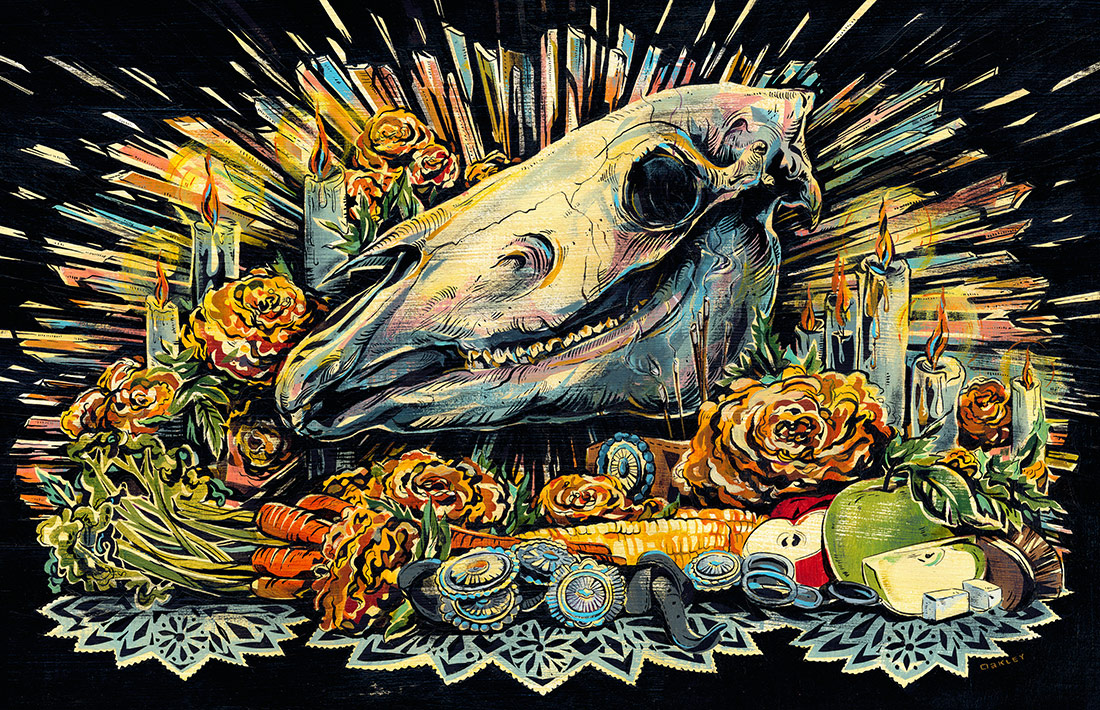
“Do good work, put time and effort into it, and stay connected to what’s going on, but do work that feels like you.”
Is there anyone who has encouraged you the most along your creative path?
It’s been different people at different times in my life. I wouldn’t be where I am today without my peers from Sheridan. We helped and encouraged each other so much during school. Once we graduated, we did a lot of shows together and took trips to New York to knock on art directors’ doors and that sort of thing. Having them helped because we were all struggling together. Once you graduate and go out into the working world, if success doesn’t happen right away, it feels like you’ve failed. To know that you’re not struggling alone is a good thing. It’s also nice to have that friendly competition with your peers because it makes you want to become better and step up your game.
In recent years, it’s been my husband, Jamie, who is a designer and painter. We work together in the same house and we each have our own studios—he’s across the hall from me. His studio usually has metal wafting out of it and I don’t know if I could work to that all day. (laughing) He’s been helpful in reminding me what I want to accomplish in my work and hopefully I’ve done the same for him. We challenge each other to not overthink things or get hung up on stuff. We also give each other really honest feedback. Sometimes it’s not great to hear, but it always works out in the end.
When you were growing up, did your parents encourage you to draw?
They were definitely supportive even though they’re not artists themselves. My dad is an engineer, so he’s a good draftsman if he has a ruler on hand; otherwise, it’s not very pretty. My mom does well when she’s doodling, but has never given any energy to doing art professionally. They’ve always been encouraging with anything I’ve wanted to do. When you decide to start your own business, no matter what you’re doing, it can be hard for parents to see you struggle and not get work right off the bat. Thankfully, my parents have always been really patient and understanding.
Do you feel a responsibility to contribute to something bigger than yourself?
I’m not sure if I feel a responsibility. In the first few years after college, you are so focused on what you want your work to be and on just getting jobs so you can earn money. That takes up a lot of your time.
Then, about six years ago, I was asked to teach. I wasn’t planning on teaching and I was really nervous to do it, but it’s been a good experience. Hopefully I’ve been giving some good advice to students and have given back in that way. Otherwise, I just do the work I’m happy with and hope that others also enjoy it.
Have you learned anything through the process of teaching?
I’ve learned so much. I had already started teaching dance before I started teaching illustration. I taught dance to a group of adults and they were all paying for the class and wanted to be there. I was a bit nervous about teaching a bunch of art students who didn’t necessarily want to take my class, but had to.
As a teacher, I hear myself give advice to students and in the back of my mind, I think, “I should do that.” As I do my own work, I try to put my advice into practice. Also, I have to break down my process so that I can explain it conceptually and visually. That helps because every time I talk about my methods, I figure things out a little more. Thinking about out how to communicate your process to others helps you break it down and reminds you to get out of bad habits, which we all get into. (laughing)
Are you satisfied creatively?
I’m not unsatisfied, but I always look at the art I do and think I could do better next time. I’m trying to be more happy in the moment, which can be a bit difficult. To be a good artist, you have to learn to be critical so you can figure out what you want to change or how you want your work to evolve down the road, but you also have to have a balance so that you’re not too hard on yourself. I think it’s a struggle for a lot of us to figure out that balance which makes us want to move forward and get better without feeling like we’re in a constant uncomfortable struggle.
Do you have any thoughts about what you’d like to do in the next 5 to 10 years?
I’m not really sure. Editorial illustration tends to be my bread and butter most of the time and I would love to do more collaborations outside of that. However, I like the idea that I don’t know what’s going to happen. If I had known ten years ago what my career would be now, I would have been really surprised. I’d like to think that in another ten years, I’ll be surprised again. That idea is exciting; if I knew exactly where I was going to go, it’d be really boring.
If you could give advice to a young illustrator starting out, what would you say?
Try to feel sincere in what you do, even though you’re really unsure of yourself in the beginning. It’s a constant evolution. At times, I thought I should change the way my work looked so that it was more fashionable or trendy, but instead, I stuck with it. Because of that, I feel like my work is more true to myself and hopefully that comes across to people. Do good work, put time and effort into it, and stay connected to what’s going on, but do work that feels like you. Add things into your work that you’re inspired by; then your work will change and adapt in its own way rather than being forced by what is fashionable around you at the time.
Your work has a wonderful quality to it. Do you do most of it by hand?
I mostly do everything by hand. Sometimes I do work digitally. For example, I might ink the lines by hand, scan the image, and then add some pre-scanned painting textures from my work so there are still traces of my analog work in there. However, most of the time I do work by hand because I’m on the computer so much; it’s really great to get away from it. When I paint or ink by hand, I feel more connected to what I’m doing and inspiration hits in a different way. I also feel like there’s something special about having a finished piece of art that you can have and hold. Although, saying that, I know a lot of people who work completely digitally and their work is completely gorgeous.
How does where you live impact your creativity?
I live in Hamilton, Ontario, which is a smaller community outside of Toronto. It’s a steel city and is a little grittier. There’s actually a blossoming art community here; several illustrators I knew from Toronto have moved here because you can get bigger studios for less money. I don’t think there’s anything particular about the city that affects my work, but I do like the people and the character of the place.
Is it important to you to be part of a creative community of people?
Yes. Like I said, I wouldn’t be where I am if it wasn’t for my peers from school—I probably would’ve given up. As a freelance illustrator, I work by myself and have hermit tendencies. Within the last year or so, I finally caved in to Facebook, Twitter, and Dribbble, which has been an amazing experience. Being in touch with other creatives has been helpful and opportunities for collaborations have come through that. Also, it’s been fun being in contact with people whose work I’ve admired over the years and never thought I’d have the chance to connect with.
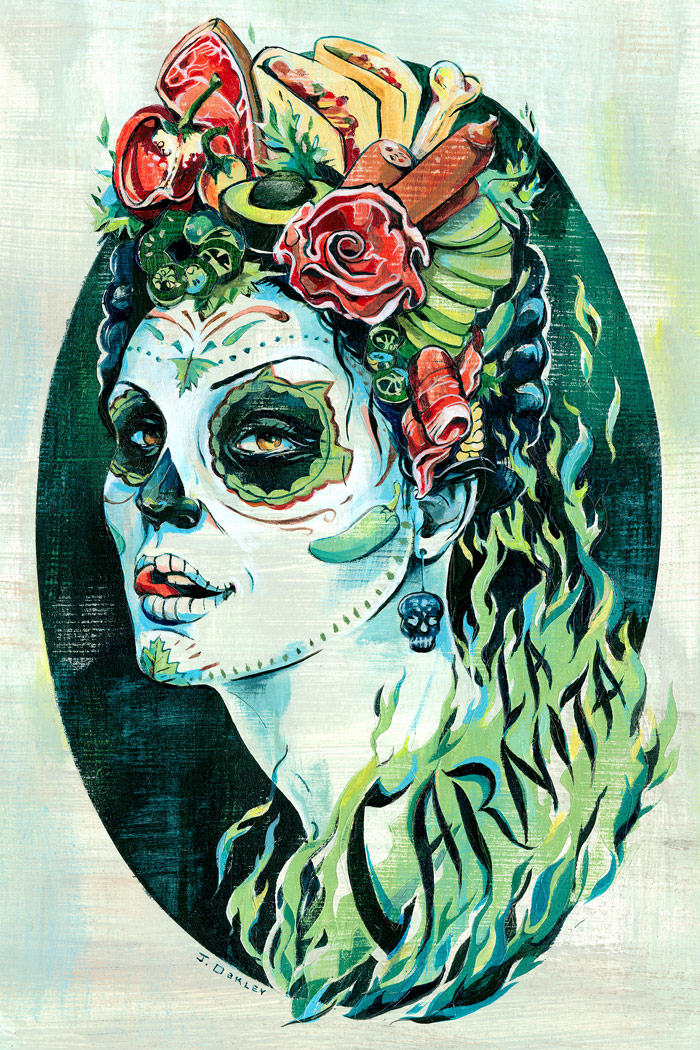
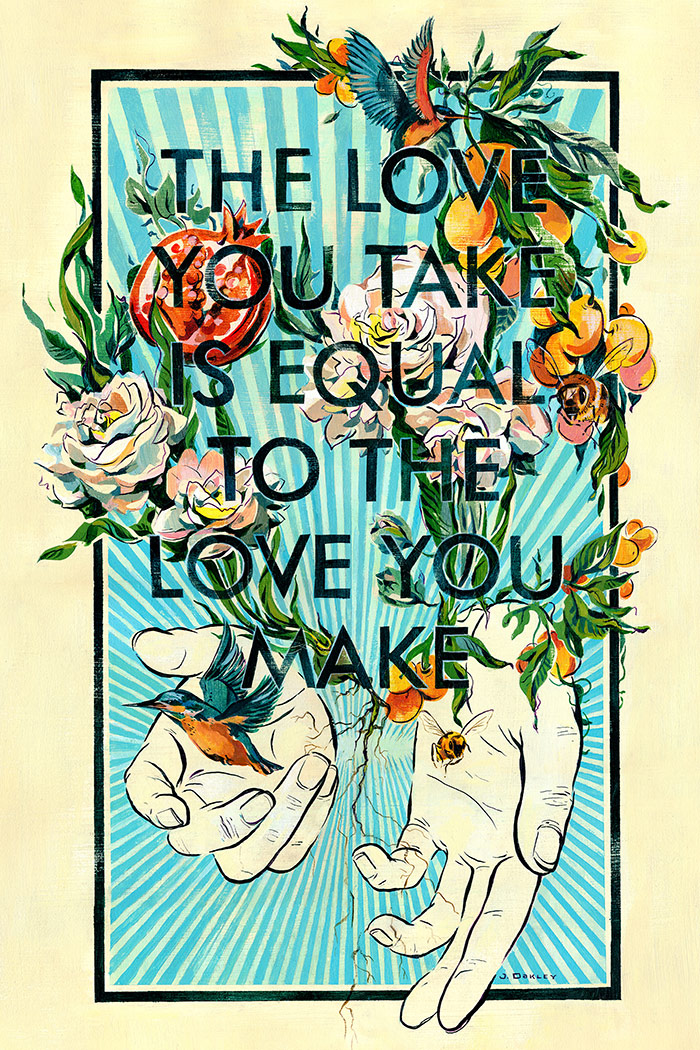
What does a typical day look like for you?
I’m not the earliest riser. My husband is usually up before me and then he’ll wake me up. I always think I should get up and do some exercises or relax beforehand, but I go and check my email right away, which is probably not the best thing to do. I respond to emails and then get on to whatever work I have to do. After work, I might go out dancing or hang out with friends—I like to try to have a good work-life balance, but my husband and I do end up spending a lot of time working in our studios.
Current album on repeat?
My taste is all over the place. I don’t know if there’s a specific album right now. I listen to prog-rock like King Crimson, early Pink Floyd, and Yes; Bowie, The Zombies, and other Britpop; early funk like Zapp & Roger; and pretty, sentimental stuff like The Beach Boys. I like anything that moves me in a way that’s either really dramatic or quiet and atmospheric.
Do you have any favorite TV shows or movies?
Deadwood, The Wire, which I love, and The Prisoner with Patrick McGoohan—I could watch that one over and over again.
Do you have a favorite book?
I read a lot of sci-fi books. J.G. Ballard’s The Drowned World is one of my favorites. I also like the work of Phillip K. Dick, Cordwainer Smith, and Burroughs.
Favorite food?
I’m a big chocolate fan—not the fancy dark chocolate, but basic, boring milk chocolate.
Do you have a favorite chocolate?
There’s a chocolate bar in England called Galaxy that’s pretty good; so is Lion Bar, if you want to buy me a gift. (laughing) Whenever family visits from England, they bring a big suitcase of chocolate.
We’ll tell our readers to mail chocolate bars to your studio. One last question—what kind of legacy do you hope to leave?
That’s a really hard question. I guess it’s something I don’t even want to consider because there’s so much more ahead of me. I hope to make images that some people like; to have good relationships with people; to have a good work-life balance; and to be seen as a sincere person—I hope my excitement about what I enjoy comes across to others.
